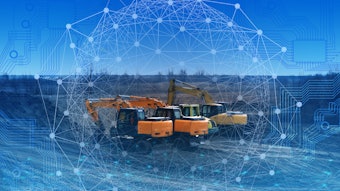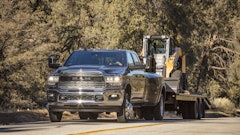
In discussions with contractors, we talk about technology – and the rate at which it will be implemented — which generates both smiles, and skepticism. While all of us in the industry are still watching and waiting to see how technology will revolutionize the business, we can start to visualize what construction equipment will look like in the future, based on developments in agriculture equipment, automation technology and investments into sustainable programs.
Here are five predictions about how the next generation of construction equipment could work.
1.Excavators will not just move earth, but also see through it.
Like SmartGrade 2D and 3D machine learning technology, John Deere’s “See and Spray” technology allows operators to work with the equipment to ensure the job is efficiently completed. First introduced during the Spring of 2021, the See & Spray system allows producers to tell the difference between a weed and a plant through a high-powered camera lens and software.
 RDO
RDO
Now, consider that technology on a backhoe excavator. With similar cameras and machine learning, the excavator could identify the fiber optics under the ground, allowing the operator to discern between dirt and fiber, preventing a potentially hazardous and costly dig-in. While John Deere and other original equipment manufacturers (OEMs) have developed and built SmartGrade 2D and 3D capabilities with automatic boom and bucket control, virtual fencing, and overdig protection, adding additional computer visualizations would help operators and managers to virtually map out potential hazards.
2. Operators will multiply. . . their productivity.
In 2022, contractors often lament labor force challenges, and the lack of skilled workers due to many professionals retiring, among other factors. In fact, Associated Builders and Contractors Chief Economist Anirban Basu said, “the next six months will be like the last six months, only worse.” To combat the prolonged labor shortage, companies like Teleo, a construction robotics company, offer a potential solution to fleet managers looking to make the most out of the labor they have: retrofit their construction equipment with technology that gives one operator the ability to control multiple machines.
Teleo’s Supervised Autonomy technology allows operators to control four to five machines from one remote control panel. In June, Teleo announced a partnership with RDO Equipment Co. and RDO Integrated Controls. In this case, the marriage of Teleo’s technology and RDO’s service will allow fleet managers to attract talent with lower experience requirements. That opens a broader pool of candidates with opportunities for them to learn and grow. That’s a pattern I expect to become more common.
For contractors who accept jobs that are in remote areas, Teleo’s Supervised Technology could allow equipment to operate without operators physically at the job site, reducing commute time, and personal safety risks.
 RDO
RDO
3. More contractors will go green.
The rising cost of fuel and supply chain issues are motivating more companies to invest in sustainability and set goals. During January of last year, John Deere first announced its E-Power Backhoe, an all-battery prototype built off the current 310L 100-horsepower diesel equivalent. Estimated to reduce emissions by up to 83 tons and eliminate more than 7,300 gallons (about the volume of a large U-Haul truck) of diesel fuel, this machine is currently in Phase One of a four-part proof of concept test.
This machine's performance will give us clues to battery-powered machines’ availability timeline as Deere plans to not only have an E-Powered Backhoe, but up to five or six different machine forms that are fully electrified, putting Deere on a path to a greener earthmoving fleet. In fact, by 2026, John Deere plans to deliver 20-plus electric and hybrid electric equipment models as a part of their "Leap Ambitions". According to the Association of Equipment Manufacturers, electric-powered compact machines have gained the most traction in 2022 and are a promising sign of what’s to come.
As high-powered batteries are developed, larger machines could be retrofitted to test how their electric components and overall perform hold up in harsh environments. Contractors also should watch how the Infrastructure Investment and Jobs Act (IIJA) addresses vehicle charging station availability, as large equipment will require a charging strategy, whether that’s a mobile charging station or operating full or hybrid electric machines in shifts.
Contractors and OEMs are both motivated to keep every machine running and complete projects on time. During the supply chain shortages because of COVID-19, manufacturers and contractors began “used parts” or “We Buy Equipment” programs to upcycle parts and equipment to those who needed it. These initiatives now work into manufacturers’ larger strategies to ensure equipment stays affordable. In John Deere’s 2021 Sustainability Report, the company set a goal to achieve 95% recyclable products by 2030.
4. Technology will help us keep a closer eye on safety.
For the past several years, we’ve seen how connected machines not only offer fleet managers data on each machine’s fuel utilization, productivity and planned maintenance but also can implement safety features.
For example, Arcure, an artificial intelligence (AI) company enhancing the autonomy of machinery, developed the Blaxtair pedestrian detection system. This technology can slow or stop a piece of construction equipment or stop the turret of an excavator from hitting a pedestrian with the bucket. While still in the early development stages, the technology is promising.
And, jumping back to an earlier point, semi-autonomous technology is already available from Teleo will allow operators to safely work away from dangerous environments that mining or heavy construction jobs sometimes require.
Finally, connected machines will have portable display monitors for remote operators and fleet managers. More like a tablet, monitors that display the machine’s data could allow fleet managers to take it from the office to the job site. This way they could download and leverage data sets at the end of the day after the operators have used the display to manage multiple machines.
5. Autonomous machines will definitely see the light.
LIDAR, or Light Detection and Ranging, is already offered by Topcon, a construction and geospatial equipment manufacturer. For example, Topcon's six-lens digital camera system provides 360-degree, high-resolution spherical images, captured as a fleet manager drives their job site. This produces an accurate jobsite’s map, featuring easily recognizable features on the environment's surface from every angle. Simple office software is then used for viewing, processing, and projecting data in GIS or CAD software.
If equipment uses this type of computer visualization along with existing machine control technology like SmartGrade, we could understand how a machine reads three-dimensional topographical, aerial maps created by LIDAR and uses its data points to perform tasks through automatic machine control. Then, maybe – we could understand every step to a fully autonomous machine.
That said, many more tests will need to be completed so contractors can understand how the machine drives and reads the road. Additionally, regulations and insurance requirements may shrink where this type of equipment could be used, but its pool of possibilities could expand in the next 10 years when contractors have more data points.
While several advancements for construction equipment technology may be in-flux, we can agree that the ever-growing presence of computer visioning, machine learning and machine control within construction equipment is paving the road to a future of automation.



























